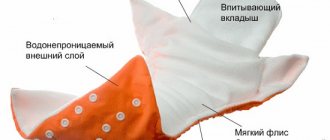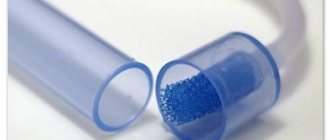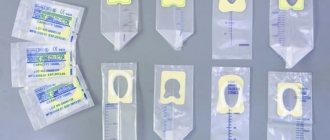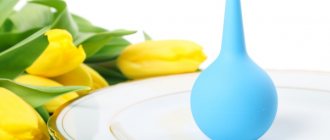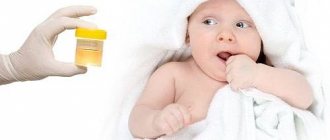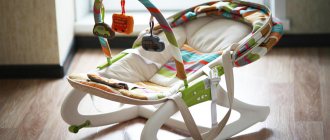February 13, 2019
Averyanova Sveta
By six months, the child no longer has enough mother’s milk; complementary feeding with fruits, vegetables, and meat is required. To make the process of getting to know new products interesting and simple, modern mothers use a nibbler.
This is a special mesh for babies that will teach them to chew without the danger of choking on a piece of food. We’ll tell you in more detail how to use a nibbler, when to start feeding through a mesh and which device is best to buy.
What is it and what is it for?
Nibbler is a children's gadget for self-feeding, an assistant for moms and dads. But this device has been known since ancient times. The great-grandmother of the nibbler was ordinary gauze or thin cloth; our ancestors wrapped crumbs, fruits, and meat in them and fed children. This is how the baby learned to chew, eat food on his own, and master new tastes.
The modern nibbler has an improved design. It consists of several parts: a mesh made of fabric or silicone, a holding mechanism for the nozzle, a handle, and a cap to protect against dirt.
Cut fruits, boiled vegetables, bread and other goodies are placed in a food container (strainer). Screw the lid on and give it to the child's hand. The baby sucks the silicone nozzle, presses the gums onto pieces of food and squeezes out the juice from them. That is, he does not chew pieces, but drinks only the liquid that is secreted; he can swallow puree squeezed out of small holes in the mesh.
Some parents wonder why buy a nibbler if you can start feeding your baby purees, cookies mashed in milk with a spoon.
Of course, using a nibbler is not a mandatory stage of a baby’s development; it’s easy to do without it. But the use of such a device allows mothers to relieve their hands and teach their baby to be independent. Another important argument in favor of nibbler: the child receives not thermally processed puree as food, but fresh fruit.
On a note! Nibbler is also called fruittaker, chewer, fruit nipple, feeder. These are synonyms for the name of the same device for chewing food by babies through a strainer.
Nibbler danger
Regardless of which nibbler you choose, silicone or with mesh, both options are safe for the child.
- However, it is still worth keeping an eye on your baby while he is playing with this device. This is due to the fact that some children who have just begun to master this toy can squeeze out too much juice with their gums and simply choke on it;
- In addition, you need to check the container for damage every time;
If you notice that the integrity of the mesh or silicone container is damaged, you must replace them immediately! Otherwise, through such a hole, even if it is very small at first glance, too large a piece of food may get to the baby and he will choke.
And do not forget that you need to select a suitable mesh based on the age of the child:
- For babies up to 8-9 months, a small nozzle with holes of a minimum diameter is suitable;
- After this, it can be replaced with a longer and wider one.
We recommend reading: Sleds for twins and the same age - a review of worthy options
A nibbler is a good toy for a child and a way to distract your baby when you need to do something without the child in your arms.
However, the chewing skill, thanks to sucking the nibbler mesh, will not appear and will not be consolidated.
Your baby is at an age when he is ready to chew and become familiar with solid pieces of food rather than purees. If you skip this age, then the child will be given solid food, require only purees, and all this can last up to 2-3 years.
Therefore, it is important not to be afraid to introduce your baby to pieces of food and introduce complementary foods correctly, while maintaining his desire to eat.
From what age can it be used?
A fruittaker can appear in the house for active use when the baby is 5–8 months old. It turns out to be a long time run-up. But the fact is that the need to accustom a baby to a nibbler depends on the following factors:
- What type of feeding is the baby on? If he is artificial, then complementary foods are introduced earlier, at 4–5 months. The purchase and first experiences of using fruit nets should be dated to this period. If a small child is breastfed, then the introduction of complementary foods is postponed for a period of 6–7 months, which means that the nibbler will come in handy a little later than with artificial ones.
- Is the baby cutting teeth? Use a fruit taker to help with baby teeth eruption. This process can begin either at 4 or 8 months.
- Are fruits and vegetables allowed for the child? Allergic children receive complementary foods from sweet, juicy plants and meat no earlier than 6–7 months, when the immune system is stronger. The need to use a nibbler is delayed until this age.
Another important factor that mothers should take into account when deciding to give their baby complementary foods through the mesh is the opinion of the doctor. If your doctor allows the introduction of new products, feel free to buy a fruittaker and use it without fear.
Opinions for and against
The usefulness of nibbler for a baby is determined by each parent independently based on personal experience or stories from friends. Here are the most common arguments for and against feeding nets, voiced by opponents and supporters of the device.
pros
Proponents of using fruittaker talk about the following positive aspects of a modern children's gadget:
- The baby will not choke on pieces of food. The mesh does not let fibers or crumbs through, only juice gets into the child’s mouth. It is safe for a toothless baby.
- Nibbler helps teeth erupt, scratches gums and relieves itching in the areas of future incisors. If you put chilled fruits in the net, the process of chewing them turns into real relaxation for the baby.
- You can give it to your child on the street, while traveling in the car. The baby sits in the stroller and eats, is busy with work, and is not capricious.
- Using a feeding net you can expand your baby's diet. Any fruits and vegetables that are so difficult to give in pieces are placed in it. For example, fibrous orange, hard pineapple.
- The bright design attracts babies, the nibbler becomes a favorite toy.
- Low price. You can buy a good footer at a pharmacy for 250–600 rubles.
Minuses
Among the disadvantages of using a nibbler are the following:
- A silicone or fabric mesh quickly deteriorates, losing its aesthetic appearance from the juice released by fruits and vegetables.
After several uses, the bag becomes dark in color and is difficult to wash. You need to buy replacement nets at least 2-4 times a month. But this only applies to the fabric version of the nozzle. - Vegetable and fruit juice flows out of the container when pressed with gums and lips. As a result, while eating, children get dirty and their clothes become dirty. And if you use the Nibbler while walking in a stroller, the seat and armrests become dirty.
- The device is heavy for a 4-6 month old baby. If you put fruit inside and give it to the baby, the baby will have difficulty holding it on his own. The mother has to help the baby, so we are not talking about independent feeding.
Kinds
There are several types of devices on the market today. All of them are made according to the same principle. But different manufacturers have solved the question of what a nibbler is in their own way.
Nuby
A famous American brand specializing in the production of children's products. The company introduced a feeder that looks like a rattle. The handle is made of rubberized plastic in a bright color and is thick enough to allow the child to hold the device comfortably. A nylon bag is used, where you can put products of different volumes and shapes.
Nuby is the first brand to introduce such products on our market. That is why the company's products are widely distributed in the pharmacy chain. Based on reviews from mothers, you can determine the advantages and disadvantages of devices.
Pros:
- can be found in any city;
- bright, interesting design that all kids like;
- two colors - blue and pink, which allows you to choose a nibbler according to the gender of the child.
Minuses:
- costs more than other types of mesh, the price starts from four hundred rubles;
- The replacement nozzles themselves, which will have to be changed periodically, are also more expensive;
- the handle is so beautiful and comfortable that it is more likely to interest the child than the contents of the mesh itself, and the baby will enjoy gnawing on it.
Such a nibbler can be an excellent gift for a baby whose diet is being introduced to complementary foods.
"The world of childhood"
Russian analogue of American products. It is equipped with a nylon bag and is sold under the name “Weaning Net”. It has a number of design features. The handle is rounded, which allows you to give it to a baby or tie it to a high chair for feeding. In this case, you won’t have to bend down for the net every time your baby drops it on the floor.
Pros:
- high-quality analogue at an affordable price, replaceable nozzles are also inexpensive;
- convenient design that allows the baby to become interested in the contents of the container.
Minuses:
- less widespread in the pharmacy chain, more difficult to find and buy;
- when chewing a nylon bag, its contents can leak not only into the child’s mouth, but also to the sides.
The last drawback is noted by mothers when using all feeding nets of this type, regardless of the brand.
MamaSense
Products of an English company that enters the Russian market under the name fruittaker. It differs from other types of devices in the material from which the container is made. It is silicone and maintains its shape well. It has many small holes that allow the baby to “get” complementary foods. The rounded handle, similar to the model from World of Childhood, is designed to be grasped by a child’s hands and secured to a high chair.
Pros:
- the container has a denser structure, when the baby eats, the contents do not splash to the sides;
- gum massage is better;
- The silicone container can be washed and dries quickly;
- The volume of the mesh is small, it fits well in the baby's mouth.
Minuses:
- the shape and small volume of the container do not allow large pieces to be placed there; the product will often have to be added in micro portions;
- the cost of the device is higher than that of Russian production;
- There are no replacement attachments; if the container wears out, you will need to buy a new device.
The question of which nibbler, silicone or with a mesh, is more convenient, requires an individual solution. There is no consensus on this matter. You may need to try both models.
Which one is better to choose?
To buy a high-quality accessory for feeding your baby, we recommend paying attention to the following characteristics of nibblers:
Firm
Trust trusted and world-renowned manufacturers. Perhaps the device will cost more than more economical analogues from unknown companies, but it will last longer and will not harm the baby’s health. We recommend buying nibblers from Nuby, Canpol Babies, MamaSense, and domestic companies. Never consider purchasing Chinese options, for example through Aliexpress.
Material
Be sure to see the composition of the material in the instructions for the device. If the instructions indicate that the product has been tested by dermatologists, recommended by pediatricians and meets quality standards, feel free to buy it. Strong-smelling, cheap plastic and silicone can be identified without special skills.
Inspect the nibbler, smell it, click on the mesh. If what you see does not inspire confidence, refuse to purchase.
Mesh
There are two options: silicone and textile. Choose according to your child’s financial capabilities and preferences. Please note that there is a replaceable mesh, the possibility of replacement after prolonged use.
Comfortable handle
The baby will use the nibbler independently, so the handle of the device should be ergonomic for a child’s palm. The important information here is from how many months the baby will eat through the mesh. If from 5–6 months, choose an oblong-shaped handle, in the form of a ring; for older babies, choose a round one.
Nibbler weight
Ask the seller how much the gadget weighs. It will be difficult for a child to support a container with food weighing more than 200 grams. The lighter the nibbler, the more attractive it is to you.
Availability of additional parts
These are caps to protect the mesh from dirt and dust, a mechanism for pushing food debris forward and replaceable nozzles. The more functionality, the more convenient the nibbler.
On a note! Which nibbler to choose and how to use it correctly, says Dr. Evgeniy Komarovsky in his TV show.
Review of popular children's "chews" or "fruit takers"
A net for feeding babies fruits, vegetables, and berries is a very popular product, which is why there are a large number of “chews” for children. They can have shaped or solid handles, lids of different designs, as well as different mesh materials and their volume.
"Nuby"
Nuby is the most versatile nibbler on the market. After all, it has two options: with a silicone mesh and with a fabric one. The only difference is the price and preferences of the parents. Each of the company's fruit takers is equipped with a rubberized handle that will not allow the child to drop the feeder. There is also a cap, thanks to which you can confidently take the nibbler outside or on a visit. "Nuby" is available in different colors. Fruit taker handles can also be modified, depending on the release model.
"The world of childhood"
Budget option for fruit taker. It is available with handles in different colors
Please note that the mesh is replaceable. The disadvantage is that components (mesh) need to be purchased
At the same time, the handle will be comfortable for the baby, because it is light in weight. The mesh in the World of Childhood feeder is fabric. The kit also includes a lid. This allows you to use the “chew” on the street.
"MamaSense"
This type of fruit taker is distinguished by its silicone mesh. At first glance it is too thin, but in use its strength is confirmed. "MamaSense" is well suited for children due to its comfortable handle. Despite the small amount of space for food, the nibbler helps keep the child occupied for a while and allows parents to do the necessary things
In addition, this fruit taker has bright colors that will attract the attention of the child. The silicone mesh is also changeable and can be purchased additionally.
"Happy Baby"
One of the most popular nibblers. The main part of "Happy Baby" consists of silicone. Thanks to this, your baby will be comfortable chewing and will not damage his gums. The big advantage of the feeder is the mechanism that allows you to move food debris closer to the mesh. In addition, the nibbler is equipped with a reliable fastening, so the child will not be able to open the net with food on his own.
Did you know? Today, baby strollers are equipped with many additional accessories and functions. We couldn’t even dream about this before, but we couldn’t even think about it. And the stroller was invented by landscape architect William Kent.
In the 18th century, you could even harness a pony or a dog to a carriage.
Nibbler for complementary feeding
There is also a nipple nipple for complementary feeding. It is smaller in volume than the above fruit takers. However, it does not differ in functionality. You can also put berries, fruits, and vegetables in it. It is interesting because the child will suck it like a regular pacifier, but there will be pleasant goodies inside.
DIY nibbler
If you are not ready to spend money on a nibbler, you can make it yourself. To do this you will need:
- jar (usually a jar of vitamins is used because of the convenient lid of the right size);
- tape measure;
- awl;
- paper on which to draw a pattern;
- ribbon or braid, at least 15-20 cm long;
- threads;
- sewing machine;
- mesh (often used is a mesh for washing clothes, which can be purchased at any hardware store);
- sandpaper;
- stationery knife;
- scissors.
Initially you need to trim the jar.
Next step:
Important! It is recommended to make several replacement bags at once.
Which material is better
Pharmacies sell different types of nibblers based on color, size, and manufacturer. There are also two types of attachments: silicone and cloth (nylon mesh). It is impossible to say unequivocally which one is better. Each has its own pros and cons. Let’s compare both materials to make it easier for you to choose a fruit taker model based on this characteristic.
| Silicone product nozzle | Grocery cloth attachment |
| Soft or dense depending on the type of material for production | Soft at the initial stage of use, after which it can be slightly harder than silicone |
| Safe, if high-quality material is used, buy a branded nibbler at a pharmacy or a well-known retail chain | Safe for children. Natural textiles or nylon are used for production |
| Recommended for children during the teething period (from about six months): the mesh helps relieve itching, pain, and is used as a chewer for swollen gums. If your baby has teeth, there is a risk of biting off the material during use. | You can buy it for a child at any age and with any number of teeth; it is difficult to bite off the textile base with baby incisors |
| Does not change color when used | May darken from fruit acids |
| Easy to care for | It is difficult to wash away food residues, especially fruits and berries. |
| Replacement nozzles are rarely included with the nibbler; it is almost impossible to find replacements separately. If the silicone tip gets holed, you'll have to buy a new device. | The kit often includes replaceable mesh blocks; it is possible to buy replacement parts separately |
| Average life of the nozzle: 2–3 months | If used frequently, you will have to change the mesh at least once a month. |
| The cost of chewing gum with a silicone nozzle ranges from 250 to 500 rubles per piece | A nibbler with a nylon nozzle costs an average of 180–250 rubles |
Which nibbler is better: silicone or mesh?
If you take the statistics from recent surveys of young mothers on the topic: “Which nibbler is preferable for you?”, it becomes clear that the votes were distributed approximately equally. Mothers give different reasons for their choice, but the child determines the championship in the ranking of the best mesh containers. Some people like lightweight nylon and the natural taste of a sweet product, while others prefer silicone with a lot of fruit juice and the hope of chewing it. Each of these types of containers has its own advantages and disadvantages. You choose:
We recommend reading: At what age can you put a child in jumping chairs, their benefits and harm
| Silicone container | Nylon mesh |
| pros | |
| Hypoallergenic. | Easily replaceable. |
| Odorless and tasteless. | Low price. |
| Easy to clean and remove food residues. | Easy to clean if washed immediately after use. |
| Low percentage of wear. | High strength (not easy to chew and tear). |
| Does not deform during sterilization. | Washable well with the addition of baby gel. |
| Elastic, quickly returns to its original shape. | Comfortable to bite, chewing skills are acquired quickly. |
| Minuses | |
| It's hard to find a replacement. Not all manufacturers provide replacement containers. | Over time, it darkens and looks unpresentable, but if you hold the mesh for 30 minutes in a solution with lemon juice (acid - 1 tsp per 1 liter of water), it will lighten. |
| A child can chew the nozzle. | May cause irritation of the oral mucosa (rare). |
| High price. | |
How to use it correctly
Feeding through a feeder should be carried out according to the following scheme:
- Immediately after purchase, the new nibbler should be thoroughly washed with hot water and soap or baby dishwashing detergent, then boiled for several minutes.
- It is recommended to feed breastfeeding children and infants with fruits and vegetables after the main meal or as a snack between breakfast and lunch.
- The Nibbler should be rinsed with boiled water before each use.
- Cut the products into small pieces; hard apples can be grated.
- Place the complementary food in the mesh, screw on the lid, and check the tightness of the mechanism.
- If you want to give fruit to your child chilled, to relieve gum pain during teething, place the filled fruit taker in the refrigerator for a couple of minutes.
- Give a 6-7 month old baby the device in his or her hands; 4-5 month olds will have to help hold it for the first few days.
- After your baby has completely sucked the juice out of the food, remove any excess from the bag and rinse all parts of the feeder with hot water. Disassemble the device into its component parts: mesh, piston, cover.
- Use a soft brush to remove remaining fibers and fruit juice from the mesh.
- After washing, dry the nibbler and put it in the closet.
Important! The Fruit Taker cannot be washed in the dishwasher using aggressive detergents. Powders remain on the surface of the device and become clogged in the mesh cells. They can enter the child’s esophagus when sucking food and cause poisoning.
To clean the nibbler, use baby products or only hot water.
Design
Today, a variety of manufacturers offer a useful accessory, but any feeding device can have the following components.
Ring
A ring-shaped base of small diameter is located in the center of the product. The ring performs a connecting function. At the bottom of the nibbler, a container for food is attached to it, and at the top there is a handle that the baby holds on to. When used, the ring remains on top of the baby's lips.
Food container
Food for the baby is placed in a special container that the baby holds in his mouth. It is made of a special mesh or silicone.
Mesh
The mesh for the device is made of safe, strong nylon. The flexible mesh is firmly attached to the ring; pieces of fruit and juice, passing through the mesh, are crushed and do not become an obstacle to breathing. When washing the mesh, you should thoroughly clean all cells of food debris. During use, the mesh may become darker from fruit and vegetable juices, but this color change does not change its properties. A nibbler with a mesh has the advantage of a lower price. Its advantage is also the ability to easily select a new bag to replace a worn one.
Silicone
The silicone nibbler is made of safe and durable silicone, which resembles a large pacifier familiar to a baby. The difference from the nipple is the holes for food and juice to enter the mouth.
Silicone retains its shape even when empty, is easy to clean, and does not change color when exposed to juice. A silicone container can be boiled, and it will dry even faster than a mesh container.
These qualities make silicone nibblers increasingly popular, especially given their preference for babies who are developing teeth. At this time, the nibbler simultaneously functions as a gum massager.
At the same time, it should be noted that silicone nibblers are more expensive, and not all manufacturers offer replaceable containers to replace the bitten silicone bag.
Pen
A handle is attached to the top of the ring. Its shape and size take into account that the product is given to a child to hold while eating. The handle is suitable for baby's hands.
What can you put
When choosing products to fill the mesh, be guided by the child’s age, the presence of teeth, the baby’s taste preferences, and recommendations for the introduction of complementary foods for children. If the baby is 5–6 months old and is not allergic to fruits and vegetables, put in the nibbler:
- Any berries, fruits, but without seeds. These are bananas, kiwi, peaches, apples, pears, apricots. Citrus fruits are given after 7 months, if diathesis or allergies do not appear.
- Boiled vegetables. Carrots, cabbage, beets, pumpkin, zucchini, broccoli.
- Cookies, crackers. Not the most popular option for mesh products, but if you choose cookies that quickly dissolve from saliva, your baby will definitely like it.
- Small pieces of cooked meat. These are beef tenderloin, chicken breast, diet rabbit and turkey.
See how to properly put fruit in a nibbler.
At first, the list of products for nibbler will be small - carrots, broccoli, unsweetened pears and green apples. As the baby grows, by 6–7 months, you can already put meat, cookies, and a wider range of fruits and vegetables in it. Add new ingredients to the menu gradually so as not to provoke an allergy in the baby.
Safety regulations
Fruittaker itself is safe for infants. The fruit teat is screwed on tightly, the rotating strainer mechanism is tight - the baby is unlikely to be able to open it on his own.
It is also impossible to choke on pieces of food if the mesh has no damage or holes.
But despite all the safety benefits of the device, parents are not recommended to leave their baby alone with the feeder to avoid accidents. The instructions for the nibbler contain a list of several more safety rules:
- Replace the mesh with a new one if you see the slightest cracks or wear on the surface.
- Do not give your baby a fruit pacifier that is not full. If the baby has even one tooth, he will tear the sac.
- Check the device for integrity and cleanliness before each use.
- Do not teach your child to open the mechanism on his own.
How did you manage without this device?
Many mothers believe that nibblers were invented by our grandmothers and great-grandmothers, who wrapped millet or semolina porridge in a row (cotton, gauze) and fed their children with this sweet pacifier.
And yet, they were not the first. Mentions of linen bags with honey or poppy seeds are found in the history of antiquity. In 1506, the German artist Albrecht Durer depicted the Madonna and Child. The painting “Madonna and Siskin” is kept in the Berlin Art Gallery. See for yourself.
A siskin sits on the baby’s left arm, and with his right arm he hands the bird…a nibbler.
Of course, earlier this attribute of a children's meal was not called that, but from the beginning of the 16th to the mid-20th centuries. It was impossible to do without this device. Then the feeding net disappeared from use.
Current devices attract children with their convenient shape, bright design, and their use is based on the following principles:
- help the child adapt to unfamiliar food;
- help parents introduce solid foods as naturally and safely as possible;
- to form taste preferences and correct bite in the baby.
Rating of the best
Nibblers for infants are popular products, which is why the range of such products in pharmacies and baby goods stores is very wide. Let's present a list of the best models that have received positive reviews from customers.
Nuby
It was this brand that gave the name to the fruit taker in Russia. The company presents a large selection of chewing gums with silicone and textile attachments. The nibbler is equipped with a handle with a rubberized part; it is comfortable and easy for children to hold it independently. The kit includes a protective cap for the mesh, so it’s safe to take the nibbler with you on the road or outside.
Happy Baby
Nibblers from this company are made from high-quality silicone and polypropylene that is safe for babies. The device is equipped with a comfortable handle for holding with small hands. The main advantage of Happy Baby nibblers is the mechanism for pushing leftover food forward.
"The world of childhood"
An inexpensive option for a feeding net. The average price is 130 rubles. Made from quality material. The mesh is made of textile, the cells are small, so the child will not choke on pieces of fruit or bread. Replacement nozzles can be purchased separately; additional meshes are not included in the kit. Allowed for children from 6 months.
MamaSense
The silicone chewing attachment, according to customer reviews, is very durable, so it can be used for a long time even by children with teeth. If the mesh wears out, you can purchase a replacement one. The bright design of this company’s nibbler attracts the attention of children; they enjoy looking at the accessory, playing and eating with it on their own.
Nibbler nipple
Another interesting option for a device for feeding a child with goodies. It looks like a large pacifier with a food container inside. You can put a small amount of fruits, berries, porridge, cookies and other food there. The baby sucks it and gets gastronomic pleasure. You can teach your child how to use this device in a couple of minutes.
How to make a nibbler with your own hands
Making a homemade nibbler is easy. It will be comfortable and light for the baby. You will need:
- a small plastic jar, you can take a container for vitamins;
- awl;
- ribbon 20 cm long or less;
- gauze, textile mesh;
- sandpaper.
Start by cutting off the can. To do this, measure 10 mm down from the thread, draw a line and cut with scissors or a knife in a circle. Sand the sharp edges of the plastic with sandpaper.
Measure the circumference with a tape, divide the resulting number by 2, add 1 cm to it. This will be the width of the nozzle (mesh). Make a pattern on paper:
- Fold the paper in half. Draw a line for the width of the mesh. This is the circle number obtained after measuring the can.
- Draw a 10 cm line from the middle down. This will be the length of the mesh.
- Connect the dots in a semicircle, lay the paper flat, you get an oval shape.
- Cut out a pattern from paper.
- Attach it to the material, draw along the contour of the pattern.
- Textiles need to be folded in half to create equal parts of the mesh.
- Cut the nozzle from the fabric and sew both parts together.
- You will get a mesh. How many replacement attachments to make is up to you.
Next, we make a base for attaching the nozzle. Take the lid of the jar and make holes with an awl in two places. Insert ribbon into the holes and tie it from the inside.
Insert the strainer onto the thread ring and screw on the lid. The device is ready. You need to use a homemade nibbler in the same way as one bought at a pharmacy.
Nibbler has become firmly established among infants and young mothers and has received a lot of positive reviews, so don’t rush to give up using it, be sure to try this option for introducing complementary foods. First, buy the simplest device with a silicone mesh. When the baby learns to eat through the feeder himself and shows interest in the process, you can think about buying a more expensive accessory.
Did you like our content? Subscribe to the channel in .
